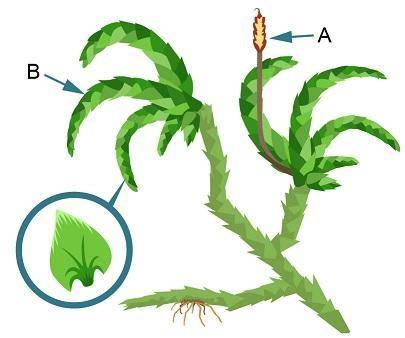
Biology, 10.03.2021 18:00 ochoachanna
A group of students was examining the moss Pterogonium gracile.
Diagram of a pterogonium gracile moss. A is a tall stalk. B is one of many branches, on which are diamond-shaped leaves.
The moss was found to have two structures:
A. A tall stalk structure that was present only in spring when the moss produced spores.
B. A brownish-green or brown branching structure that was present year-round.
The students produced several hypotheses about how the moss reproduced.
I. The branching structure is diploid and undergoes mitosis to produce the stalk.
II. The branching structure is haploid and undergoes meiosis to produce the stalk.
III. The stalk is haploid and undergoes mitosis to produce the branching structure.
IV. The stalk is diploid and undergoes meiosis to produce the branching structure.
When the students examined the moss, they found the stalk had 11 pairs of chromosomes and the branching structure had 11 chromosomes. Which hypothesis does this information support?
I
II
III
IV


Answers: 3


Other questions on the subject: Biology

Biology, 21.06.2019 15:50, haleyblu6351
Providing immunity by injecting the body with a weakened form a pathogen is known as
Answers: 3

Biology, 21.06.2019 17:00, zanaplen27
Ascientist and her team counted 200 individual deer in an area of 10 square kilometers. what is the population density?
Answers: 1

Biology, 22.06.2019 13:00, jalenshayewilliams
What is gene expression control that occurs after the generation of rna
Answers: 3

Biology, 22.06.2019 14:30, seby951
How do water’s relative densities as a solid and a liquid differ from that of most other substances? water’s solid and liquid forms have different densities, while most other substances have solid and liquid forms with similar densities. water’s solid and liquid forms have similar densities, while most other substances have solid and liquid forms with different densities. water’s liquid form is less dense than its solid form, while the opposite is true of most other substances. water’s solid form is less dense than its liquid form, while the opposite is true of most other substances.
Answers: 3
You know the right answer?
A group of students was examining the moss Pterogonium gracile.
Diagram of a pterogonium gracile mo...
Questions in other subjects:









Mathematics, 25.04.2020 04:47



